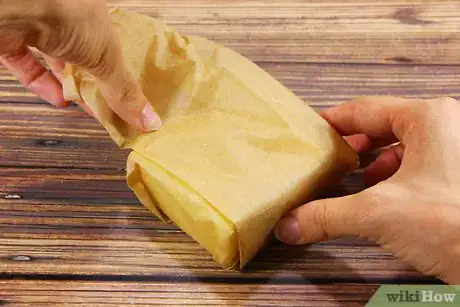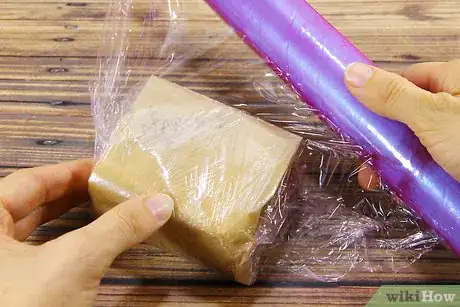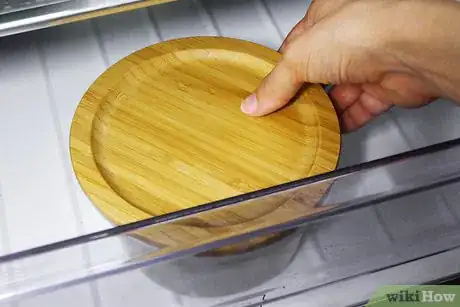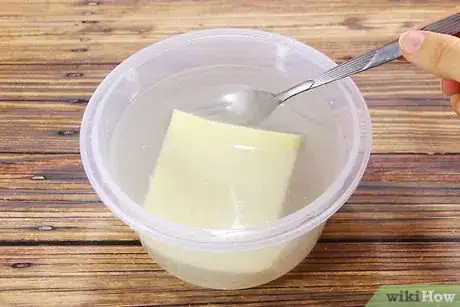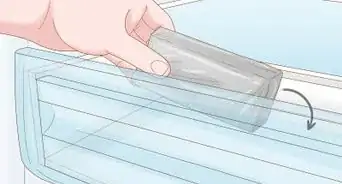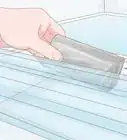This article was co-authored by Ollie George Cigliano. Ollie George Cigliano is a Private Chef, Food Educator, and Owner of Ollie George Cooks, based in Long Beach, California. With over 20 years of experience, she specializes in utilizing fresh, fun ingredients and mixing traditional and innovative cooking techniques. Ollie George holds a BA in Comparative Literature from The University of California, Berkeley, and a Nutrition and Healthy Living Certificate from eCornell University.
There are 7 references cited in this article, which can be found at the bottom of the page.
This article has been viewed 370,821 times.
More cheese, please! If you’re a fan of fromage, chances are you keep your fridge stocked at all times. Most cheeses (from hard Parmesan to soft Brie) can be stored by wrapping them in paper and plastic wrap. For softer, creamier cheeses like goat cheese or fresh mozzarella in liquid, keep them in a resealable container.
Steps
Wrapping It Up
-
1Remove the cheese from its original plastic packaging. Leaving cheese that’s been vacuum-sealed in plastic wrap in its original wrapper is a bad idea. It suffocates the cheese and can give it a plastic flavor. Gently unwrap the piece of cheese and take it out of the packaging to store it.[1]
- Smell or taste your cheese. If there’s a chemical flavor, use a knife to scrape off a thin top layer around the whole piece of cheese. That will remove the area of the cheese that’s been affected by the plastic packaging.
- If you bought cheese from a deli or cheesemonger and it’s already wrapped in wax paper or cheese paper, skip this step.
-
2Wrap it in cheese paper, wax paper, or parchment paper. Tear off a sheet of paper and lay it flat on the counter. Place your unwrapped block of cheese in the center. Fold the paper up around the cheese, creasing the folds so that the paper lies flat against the cheese, like a present. Make sure the cheese is completely covered.[2]
- A good rule of thumb for measuring your piece of paper is to tear off a piece that’s 2 times as wide as the length of your cheese and 3 times as long.[3]
- Use tape to secure the paper in place for extra protection.
- Cheese paper is more expensive. If you’re on a budget, opt for wax paper or parchment paper for a similar effect that costs less.
- Since cheese is alive and breathing, never store it in a tightly wrapped package. This way, you will allow the cheese to breathe without drying it out.
Advertisement -
3Label the cheese with the type and date that you bought it. Use a permanent marker to write directly on the paper covering the cheese or stick a label on it. Include what kind of cheese is inside (Cheddar, Swiss, etc.) and when it was purchased. This is especially important if you have multiple cheeses in your fridge so you don’t have to unwrap them all to find the one you want.[4]
- If you use a sticker label, it doubles as tape to hold the paper in place around the cheese.
- Writing the date will help you know when the cheese is expired or needs to be thrown away.
-
4Loosely wrap the paper-covered cheese in plastic wrap. Add a layer of plastic wrap as additional protection so your cheese doesn’t absorb the flavors of the fridge. Place your covered, labeled piece of cheese on a sheet of plastic wrap and roll it up. Don’t leave any parts of the paper underneath uncovered.[5]
- If you don’t have plastic wrap, a partially sealed plastic bag will work. Sit your covered cheese inside a resealable bag and close it halfway.[6]
- Never wrap cheese directly in plastic wrap. Not only can it breed more bacteria from being wrapped up too tightly, the cheese will also soak up flavor and chemicals from the plastic.[7]
-
5Keep the cheese in a drawer in the fridge for up to 1 month. It doesn’t matter which drawer you place the cheese in, as long as it’s in a drawer and not on a shelf. Drawers are warmer with higher humidity so the cheese won’t dry out. After about 8 days or if you notice an odor, throw it out. Harder cheeses will last longer than softer cheeses.[8]
- Some mold on cheese is okay. Just cut off about 1 inch (2.5 cm) around the mold with a knife and keep eating! The exception is if it smells bad or if the mold is a dark black-gray color.[9]
- Use a large plastic or glass container to store your wrapped cheeses if you don’t have free space in a drawer. Cover it tightly with a lid.
- Avoid putting cheese next to foods that have a strong odor like melon or onions. It will affect the cheese’s flavor.
Keeping Cheese in a Container
-
1Transfer your soft cheese to a tightly sealed container if necessary. You need a plastic or glass container that’s completely airtight to lock in moisture and prevent any brine from evaporating. If the original container is tight enough, leave the cheese in it. However, if it doesn’t reseal well after opening it, move the cheese to a container that can be closed completely.[10]
- If you move it to a new container, be sure to label the container with a permanent marker or sticker. Write down the type of cheese and the date that you bought it so you know how long to keep it.
- When transferring your cheese, keep any original liquid, too. Don’t drain the cheese.
-
2Keep the cheese in a fridge drawer for no more than 2 weeks. The drawers in your refrigerator have the most consistent temperature and humidity so the cheese won’t get too cold or too dry. The best drawer is the one closest to the bottom of the fridge. Ideally, your refrigerator temperature should be set between 35 and 45 °F (2 and 7 °C) for cheese-keeping.[11]
- If you’re having trouble using up your cheese before it goes bad, consider buying cheese in smaller quantities.
- Throw away cheese if there is any mold or if it smells funky. Mold on soft cheese is a sign it’s not safe to eat.
-
3Replace the brine only if it gets contaminated with a dirty spoon or hand. Contrary to popular belief, you don’t need to replace the brine if you only use a clean utensil to reach in and remove cheese. But as soon as you dip a dirty utensil or your fingers into the brine, you’ll want to change it out. Drain the old brine with a cheesecloth or strainer over the sink. Then, fill the container with new brine and seal it tightly before placing back in the fridge.[12]
- Make your own brine by dissolving 1 tablespoon (15 ml) of salt in 3 cups (710 ml) of water.[13]
- Stronger brine will preserve the cheese for longer. But keep in mind that the more salt you put in the brine, the saltier the cheese will taste.
- Don’t swap fresh water for brine. Water will dilute the flavor of the cheese and cause it to spoil faster.
Expert Q&A
-
QuestionWhy does cheese get moldy in the fridge?
 Ollie George CiglianoOllie George Cigliano is a Private Chef, Food Educator, and Owner of Ollie George Cooks, based in Long Beach, California. With over 20 years of experience, she specializes in utilizing fresh, fun ingredients and mixing traditional and innovative cooking techniques. Ollie George holds a BA in Comparative Literature from The University of California, Berkeley, and a Nutrition and Healthy Living Certificate from eCornell University.
Ollie George CiglianoOllie George Cigliano is a Private Chef, Food Educator, and Owner of Ollie George Cooks, based in Long Beach, California. With over 20 years of experience, she specializes in utilizing fresh, fun ingredients and mixing traditional and innovative cooking techniques. Ollie George holds a BA in Comparative Literature from The University of California, Berkeley, and a Nutrition and Healthy Living Certificate from eCornell University.
Private Chef & Food Educator Cheese can get moldy as it ages. If this happens to you, cull your cheese by cutting off any of the mold. Then, rewrap and label it.
Cheese can get moldy as it ages. If this happens to you, cull your cheese by cutting off any of the mold. Then, rewrap and label it. -
QuestionHow do I store cheese truckles?
 Community AnswerStore the truckles between 10°–14°C. In summer (depending on where you live), store the cheese in a refrigerator. You are advised to wrap them in waxed paper, as a plastic film will create a soggy mess. Remove the cheese from the fridge, and any wrapping, to allow the cheese the ‘breathe’ for an hour or two before serving.
Community AnswerStore the truckles between 10°–14°C. In summer (depending on where you live), store the cheese in a refrigerator. You are advised to wrap them in waxed paper, as a plastic film will create a soggy mess. Remove the cheese from the fridge, and any wrapping, to allow the cheese the ‘breathe’ for an hour or two before serving. -
QuestionCan I freeze and store the opened cheese?
 Community AnswerYes, you can.
Community AnswerYes, you can.
Things You’ll Need
Wrapping It Up
- Wax, parchment, or cheese paper
- Plastic wrap
- Marker
- Refrigerator
- Knife (optional)
- Tape (optional)
- Sticker label (optional)
Keeping Cheese in a Container
- Plastic or glass container with lid
- Brine
- Refrigerator
- Marker or sticker label (optional)
- Cheesecloth or strainer (optional)
References
- ↑ https://www.epicurious.com/expert-advice/how-to-keep-cheese-fresh-article
- ↑ https://www.thekitchn.com/how-to-store-cheese-what-to-do-100285
- ↑ https://www.seriouseats.com/2010/02/instructions-a-guide-on-how-to-wrap-and-store-cheese.html
- ↑ https://www.thekitchn.com/how-to-store-cheese-what-to-do-100285
- ↑ https://www.thekitchn.com/how-to-store-cheese-what-to-do-100285
- ↑ https://www.seriouseats.com/2010/02/instructions-a-guide-on-how-to-wrap-and-store-cheese.html
- ↑ https://www.seriouseats.com/2010/02/instructions-a-guide-on-how-to-wrap-and-store-cheese.html
- ↑ https://www.splendidtable.org/story/storing-cheese
- ↑ https://www.bonappetit.com/story/is-moldy-cheese-okay
About This Article
To store cheese, start by removing it from its original packaging. Then, wrap the cheese in parchment, cheese, or wax paper and secure the paper with tape. Next, on the paper, write down the type of cheese and when you bought it so you'll know when it expires. Finally, wrap the cheese again with plastic wrap and store it in the fridge for up to 1 month. To learn how to store cheese in an airtight container, scroll down!

